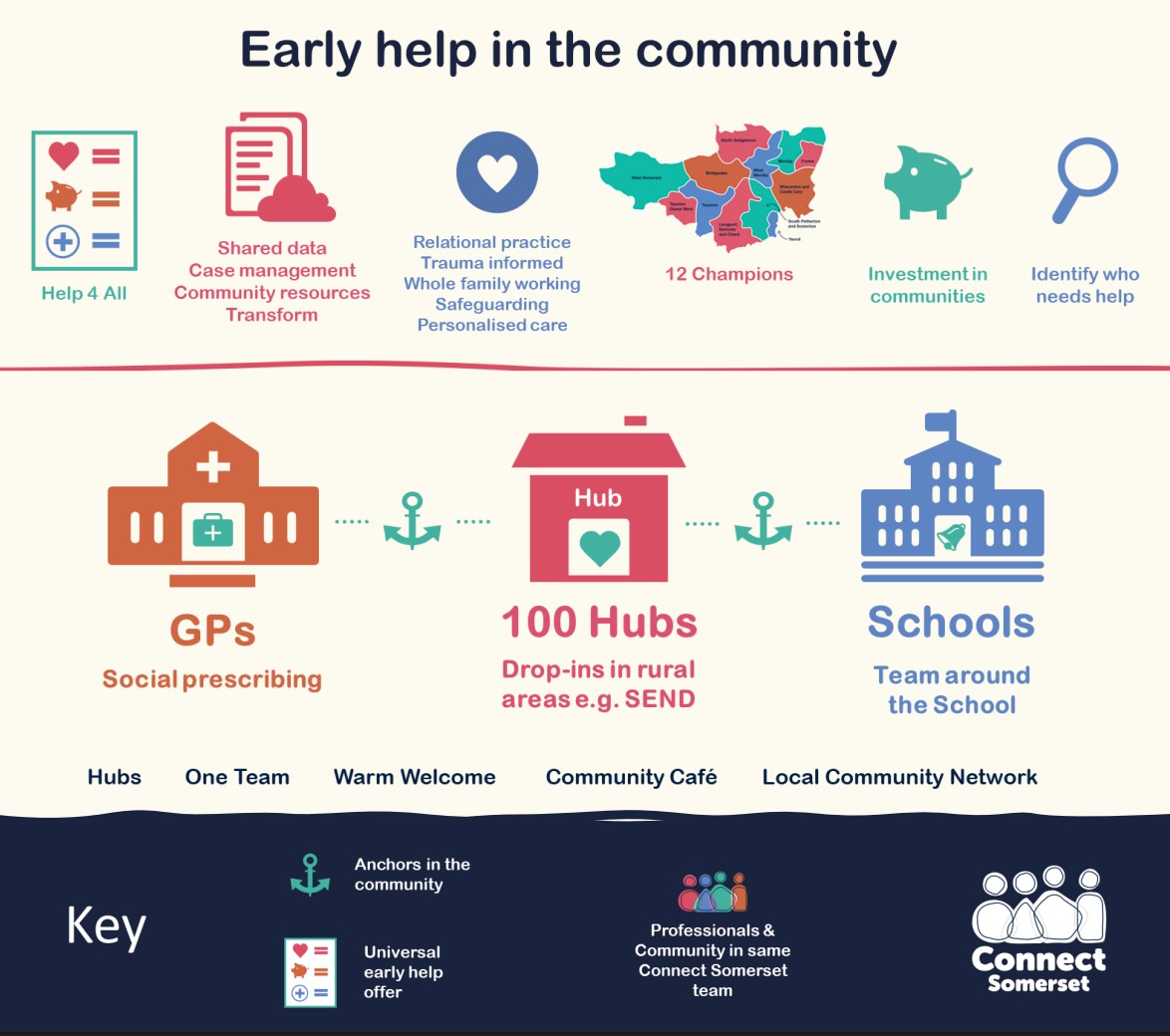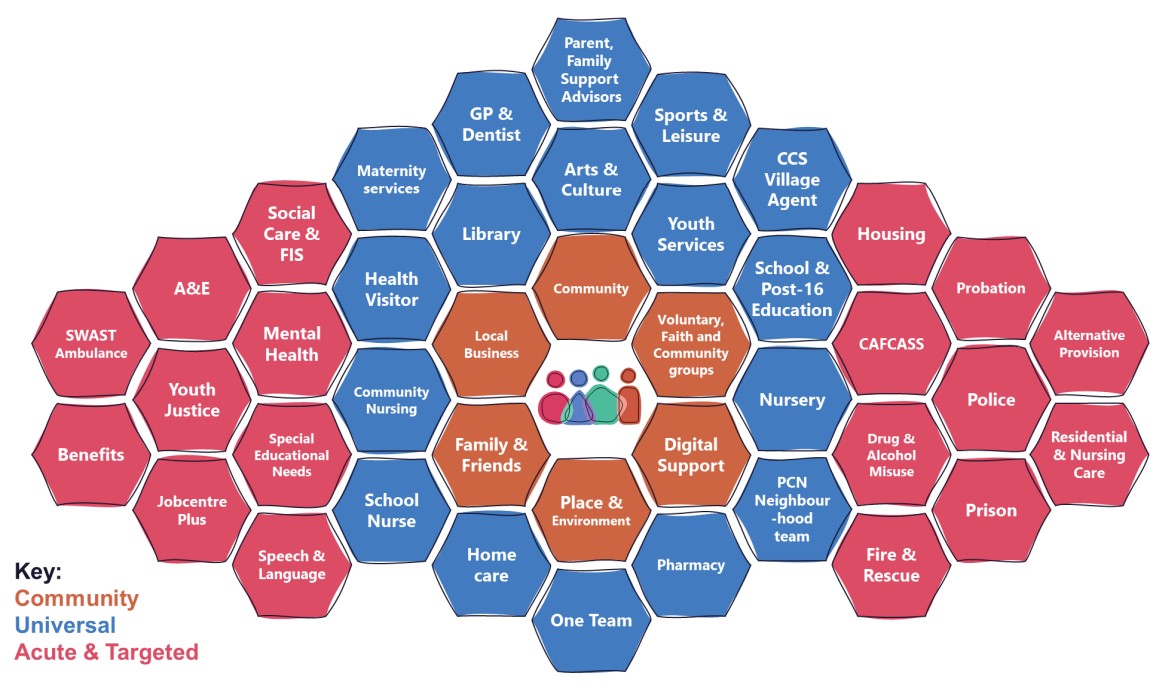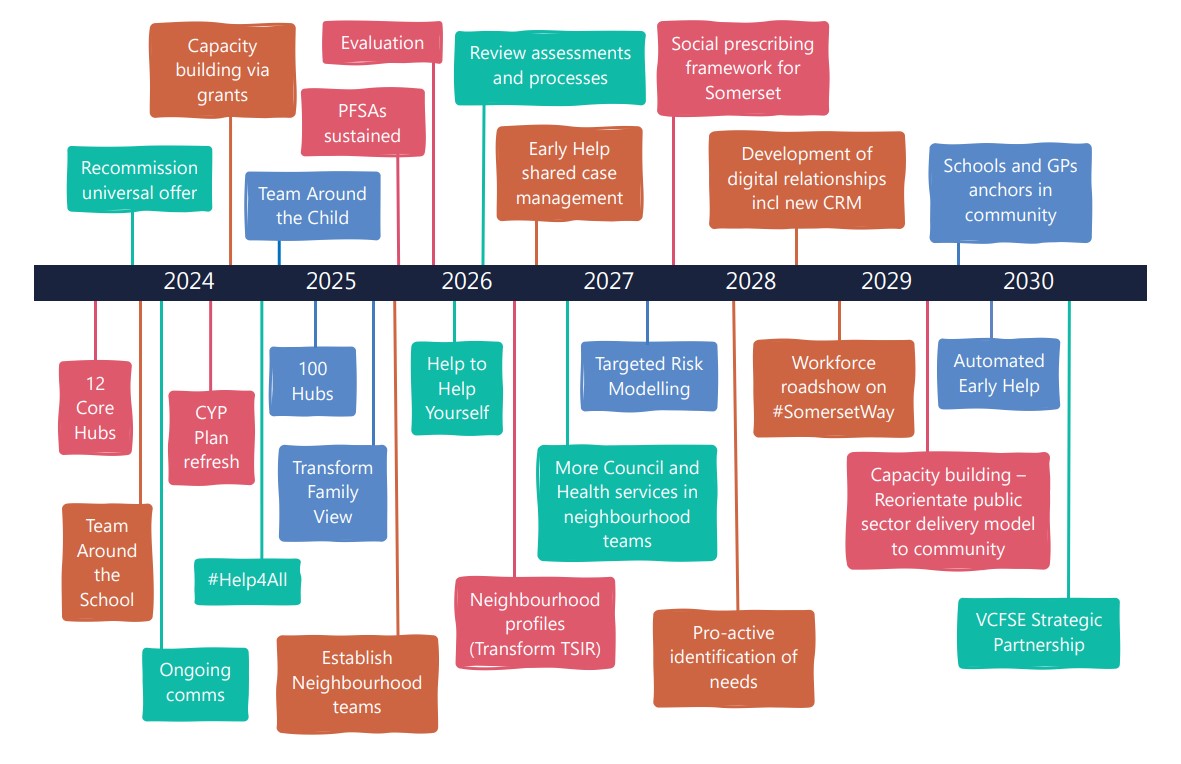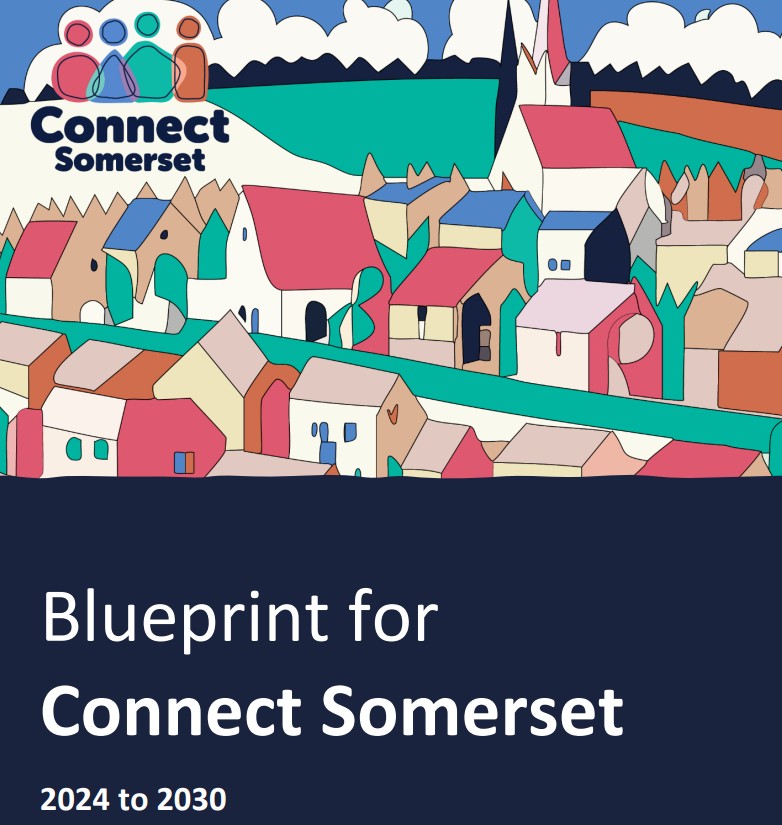Introduction
We are trying to do something quite different, and need your help. This blueprint shows how we want to evolve public sector early help for Somerset families and residents. Improving the early help system in the right way will significantly reduce costs to acute services across care, health, education and justice sectors. As well as having a big impact on the lives of Somerset residents.
Because the system of services is so complex, this is not a target operating model, but a blueprint describing our direction of travel.
Early help is the total support that improves a family or resident’s resilience and outcomes or reduces the chance of a problem getting worse.
So early help is an approach that can include informal support and a range of services that help families and residents to thrive.
We are all responsible for delivering early help.
Together, this Blueprint and our Children and Young People’s Plan are Somerset’s Early Help Strategy. And the Blueprint supports our Adults Social Care Strategy and Personalised Care Programme.
About Connect Somerset
Connect Somerset is about everyone working together to increase early help in the community. Connect somerset is not a service but a way of working together.
We know families and residents are going through challenging times. Across state funded and community sectors, Somerset services are finding it difficult to meet demand and help those who need support.
So, Connect Somerset is a big partnership that includes Somerset Council, Somerset NHS, Voluntary, Community, Faith and Social Enterprises, and Schools, Colleges and Early Years settings, and more. So together, we can develop an early help system that works well across all communities that need it.
Our big aim is to increase the help available for families and residents, and how quickly they can access that help. And we’re changing lots of small things that will add up to a new way of working across Somerset services for people.
- Twelve new Champions to lead changes to the public sector. The Champions are well known leaders in their community who are able to lead changes in how public services operate, help improve local knowledge about the community and what works, change processes and cultures.
- Hubs — we have a community hub in each neighbourhood, and there are 100 more hubs such as village halls where we want to deliver statutory and community services. The aim is to get services closer to home, and in places that the public are already at and feel welcomed. For example, the new SEND strategy includes a commitment to more local drop-ins through the 100 hubs.
- Building neighbourhood teams so professionals work better together, and families and residents can access support in a more integrated way. Starting with Champions, CCS Village and Community Agents, Parent and Family Support Advisors, Family Intervention Service, SEND support services and growing from there. Many Council and Health services could be in the neighbourhood teams in the future — delivering support closer to home, more efficiently and better integrated. Neighbourhood teams are aligned to primary care networks, adult and children’s services, although boundaries will always be fuzzy.
- Team around the school — setting up a new virtual team bespoke to each school that is there to support staff and help for pupils and their families. The team around the school is designed to promote relational practice — so professionals get to know each other working in a patch, draw on community resources and wrap support around families. We want to reduce exclusions, improve attendance and attainment.
- #Help4All offer that all frontline staff use to support vulnerable families to navigate and draw on help. Over time, #Help4All will build resilience and reduce demand. This is not about sign-posting, but hand-holding so families access more early help. Includes the new #LearnForLove parenting resources (access code ‘dragon’).
- Supporting Schools, GP Surgeries, etc to be anchors in their community — drawing on community resources through the Champions, Team Around the School and Social Prescribing. And giving back by building local community capacity. We also want to develop more funding for community services — growing capacity over time.
- Better information sharing such as through the Transform Family View app for understanding who is working with a family. And a new shared case management system available for all early help partners including schools and voluntary organisations. Too often the IT gets in the way of us working together, so we’re getting rid of this blocker. We will also get better at understanding who needs help, and offering that help earlier.
- Bring together the 50 databases describing Somerset local community resources – aggregating existing datasets and meaning that we can more easily promote local solutions and connect residents and families to what works in their neighbourhood.
- Develop our understanding of families’ and residents’ needs. By combining partner data, we can proactively offer early help before issues escalate — this will feel more compassionate than the rationing that residents sometimes experience. When we understand both needs and local community resources, we will be able to automatically connect residents to local support, sometimes without the need for a service. This is a step-change in the efficiency of early help.
- Workforce development — developing a common culture that combines trauma informed practice, whole family working, key working, relational practice and knowing the community resources in each neighbourhood. We will move away from lots of referrals to a more human and compassionate way of helping local families and residents. Tools such as the Graduated Response, Three Conversations, Safeguarding process and #Help4All will support this culture change.
- Joining up health and care, children and adults, and people and place. No community cuts neatly into different sectors, so Connect Somerset must be an integrated approach — a way of working together.
And lots more. Everything in Connect Somerset is designed to promote a culture of working together, ensuring families and residents get more help, personalising care and enabling a new and more efficient way to manage the increased demand and complexity of needs. We are all in the same team.

Design principles
Because Connect Somerset is about everyone working together, we all need to chip in when we are redesigning services or take the opportunity to change our daily interaction with families and residents. The following principles describe what professionals can do to shape our work and services:
- We focus on strengthening relationships between professionals and with children and families. People, processes and systems are caring.
- We listen to families – to understand what matters for them, to build on what is already working well and to design services, based on what we learn from individuals and their communities.
- We spend less time on diagnosis, assessments and referrals – and more time helping when people need it, stepping outside of our comfort zone.
- We use relationship based and trauma aware practice, personalised support (personalised care) and whole family working. Everyone can be a key worker for a family.
- Support and services will increasingly be based in neighbourhoods and community hubs – we work together across geographic and professional boundaries and with communities, recognising the challenges of rurality.
- We recognise that communities have different strengths and needs and work flexibly to support both individuals and communities.
- We share data and intelligence so we can offer more help to those most in need, and children don’t slip through the net.
- As a system by supporting earlier, the need for acute services will reduce over time, offering more investment early in communities and reducing inequalities across Somerset.
North Sedgemoor – Working closely with the Wessex Learning Trust to develop the Team Around the School model and to utilise the community hubs and spokes in the neighbourhood to support local key priorities, enabling statutory and community services to come together to work as one.
West Mendip – Working with Crispin and The Blue School to identify gaps in parenting offer and establish new provision. Creating links between early years, youth and adult provision across statutory, council, school, health and Voluntary, Community, Faith and Social Enterprise to promote a whole-family approach.
Bridgwater – Working with the Bridgwater Bay Primary Care Network and Social Care to connect Health Coaches, community provisions and local community spaces to enhance and compliment the provision on offer to residents.
Mendip – Linking Parent Family Support Advisers and the Family Intervention Service to the Voluntary, Community, Faith and Social Enterprise, enabling the delivery of a cohesive support package to parents and families.
Early help system
As we have said before, this is a complex system of services and community support.
Starting with the family or resident and their community, we have lots of things around us that keep us all resilient in our lives, such as friends and family and community groups.
We have the universal services that we all know and love and acute and targeted services. These all dip into early help at times and are an important part of the system.
There are between 20,000 and 30,000 working in the Somerset early help system, an example of this is shown in the diagram below.

Frome – Leading the Children and Young People Mental Health Forum meetings to support networking and partnership working.
West Somerset – Continuing the partnership with Living Better Primary Care Network, CCS Village Agents and key education and health services to provide a
health and well-being hub.
What and when
As a blueprint, we can just show the direction of travel, activities will move around as we learn more about the system and different services come on board. The following timeline image is therefore indicative.

If we are successful, then in time the public sector in Somerset will change to a more local, neighbourhood-based model of delivery. We will increase early help, invest more in community resources, and design our services to start with the individual and their community.
Yeovil – Supporting the County Lines Creative Project in partnership with Yeovil College and Bucklers Mead Academy.
South Petherton and Somerton – Enabling health and social care partners to use the Martock Information Centre and other hubs, schools and community venues to meet people within their community, reducing travel anxiety and bringing more services closer to families.
Chard, Langport, Ilminster and Crewkerne – Strategically enabling Community Leaders to focus on Early Years and the Cradle to Career initiative.
Impacts and benefits
Connect Somerset will support more families and residents to achieve better outcomes, sooner. By doing so lives are well-led, avoiding the need for more costly resources to manage the impact of crisis.
There have been many evaluations of early help, for example the national Supporting Families evaluation demonstrated a clear and attributable impact of early help, with a return of £2.28 for every £1 spent. And the austerity experiment of 2010 to 2020 provided compelling evidence that cuts to early help services leads to more expensive delivery (and much worse outcomes). An evaluation partner will show the impact of early help in Somerset through data and logic models, qualitative case studies and quantified impact and benefits.
Wincanton, Castle Cary and Bruton – Working on alternative provision for Children and Young People not attending school due to Social Emotional Mental Health needs.
Connect Somerset Programme
Direction of travel
- Change the culture of public sector services so they start with the individual, their resilience, family and community.
- Help residents to get more help, and to get it earlier so the capacity of the early help market increases, needs are met at the earliest opportunity and we improve our targeting of those that need help.
- Enhance relational practice on the ground, so that professionals work in defined neighbourhoods and are able to wrap around families and residents more efficiently.
What is it doing?
- Champions to lead changes to the public sector.
- Hubs! A community hub in each neighbourhood, and there are 100 more hubs.
- Team around the school – Setting up a new virtual team bespoke to each school.
- #Help4All offer – Universal early help.
- Supporting schools, GP surgeries and more to be anchors in their community.
- Better information sharing.
- Bring together the 50 databases describing Somerset local community resources.
- Develop our understanding of families’ and residents’ needs.
- Workforce development the #SomersetWay.
- Joining up health and care, children and adults and people and place.
- Building neighbourhood teams.
Does it make a difference?
- More early help
- Proactive and compassionate support
- Community centric design
- Increase investment in communities
- Relational practice
- Outcome based whole family working
- Acting as a lead professional (reducing referrals)
- Integration across partner agencies
Benefits for residents, council and partners
- Families and residents are independent and are able to step down from services – people have better lives.
- Less reliance on crisis and emergency services – Reducing demand on social care, HV, A&E, GPs. Police and more.
- Integration of local services in neighbourhood teams – Reducing the cost of estate and key functions such as management, triage and delivery.
- More efficient delivery models – Digital, universal services and community services and using data to identify who needs help. And offering low cost interventions earlier.
Afterword
You may have noticed that much of the Connect Somerset programme is focused on communities. There is a good reason for that.
There are three efficiencies we get from designing the early help system better:
- Universal services — sometimes when services are under pressure, they focus inward on core business, for example, teaching, policing, dealing with the caseload. Unfortunately that leads to a more expensive delivery model, poorer outcomes and experience for families and residents — increasing referrals and handoffs, relying more on process, supporting only one need for example. Connect Somerset is therefore about improving how services work together, support and coach each other. That enables us all to positively support needs we may not have been comfortable supporting in the past, and is more efficient than a referral model. In Kent, just the team around the school model led to a 22% reduction in utilisation of acute care services. So if we scale this up across GPs, Schools, Nurseries, Pharmacies, etc we can improve lives and reduce demand at the same time.
- Digital — we can increase the help that’s delivered online, but we must be careful this is not digital by default. Not everyone will find an online offer helpful or be able to afford the data, but many residents prefer anonymous and always available digital services, such as simple directories, support services like Kooth or training such as the Solihull parenting support. We can also develop the digital relationship between professionals and residents, using text-based follow-ups, small pieces of advice and guidance and Client Relationship Management software to blend face-to-face and digital. Because digital delivery is scalable at low cost, this is a good way to build resilience.
- Community — research such as Bowling Alone shows how high social capital/community resources leads to improvements in health, education, social-cohesion and safety. Even heart-attacks and cancer rates can reduce. Support in the community is more accessible for residents who do not trust or engage with public services — possibly the best way to reduce inequalities. And community buildings are often viewed as more welcoming and less threatening/judgmental. There are around 2700 charities in Somerset, not counting unconstituted community groups. There are nearly 10,000 volunteers, not counting faith-based volunteers. And often the support that residents receive from their community is life-changing — such as building life-long friendships that can be drawn on when things are tough, or peers modelling behaviour in a way that really affects your norms, and community groups that offer help at a very low price. Connect Somerset is about creating the conditions so the public sector and community can work well together in a symbiotic relationship. This draws on the best from all sectors and means support for families and residents is more than the sum of the parts.
So, given these efficiencies, why does Connect Somerset focus on communities so much?
In the public sector, we have been heavily influenced by management models that describe more transactionally efficient delivery. The way we structure our services and
governance reflects reductionist thinking. What we can measure heavily influences service design. And legal frameworks, short-term politics, government departments
and inspection have all refocused practice in narrow terms.
These all miss the point of good system design.
Our public service design almost always starts from when needs present themselves at our front door. Those coming into A&E, referrals in safeguarding, someone phoning the Police. And that’s reflected in our funding — 95%+ of spend in health is on illness not prevention, early help in the Council has reduced due to austerity, there is less money for communities.
Actually, the need started with the individual’s resilience, the environment they are in, their connections to friends and family who could help, the social capital that supports them. Designing good public sector services therefore has to start with the individual and community, not from the point that need knocks on our front door. And to be efficient in Somerset, we will have to turn-around the prevailing ideas of good service design, and embrace systems thinking and a community first approach. It’s a cultural change that takes time, so that’s why we focus on communities (alongside lots of good system design).

